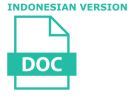Kata Satuan Bahasa Korea dalam bidang Kuliner
Ridwan Giffary Lintang(1*), Tri Mastoyo Jati Kesuma(2)
(1) Universitas Gadjah Mada
(2)
(*) Corresponding Author
Abstract
Measure word is a group of words functions as a noun counter and complementing a numeral. Each language has a different set and types of measure words. Korean has a lot of measure words and it is used based on the semantic feature of the counted noun. This paper examines types of Korean measure words in a culinary-related text. Data were collected from recipes written in Korean. Then, Data were classified and analyzed to see the similarities and differences between those measure words. Our results showed that there are four types of Korean measure words. First, measure words that are standard measurement units (e.g geuraem 'gram' and litheo 'liter'). Second, measure words that are Korean traditional measurement units like geun. Third, measure words that came from measuring tools like byeong 'bottle' and keunsul 'spoon' and the last, measure words that are classifiers. In a phrasal structure, measure words placed after the numeral, and the noun is mainly placed before the numeral but it also can be placed after the measure words by adding a genitive particle -eui between the measure word and noun. Commonly-used measure words and classifiers that have one-to-one equivalent word in Indonesian will be easier to learn by learners from Indonesian background.
Keywords
Full Text:
PDFReferences
Aikhenvald, A. Y. (2006). Classifiers and Noun Classes: Semantics. In Encyclopedia of Language & Linguistics. https://doi.org/10.1016/b0-08-044854-2/01111-1
Allassonnière-Tang, M. (2017). Explaining the acquisition order of classifiers and measure words via their mathematical complexity. Journal of Child Language Acquisition and Development, 5(1), pp.31-52. https://hal.science/hal-03018225
Djajasudarma, F. (2006). Metode Linguistik: Ancangan Metode Penelitian dan Kajian. PT Refika Aditama.
Doetjes, J. (2017). Measure words and classifiers. Revista Letras, 96. https://doi.org/10.5380/rel.v96i0.54558
Doetjes, J. (2019). Count/mass distinctions across languages. Semantics - Typology, Diachrony and Processing, 29-56.
Her, O. S. (2012). Distinguishing classifiers and measure words: A mathematical perspective and implications. Lingua, 122(14). https://doi.org/10.1016/j.lingua.2012.08.012
Her, O. S., Hammarström, H., & Allassonnière-Tang, M. (2022). Defining numeral classifiers and identifying classifier languages of the world. Linguistics Vanguard, 8(1). https://doi.org/10.1515/lingvan-2022-0006
Kim, C. (2005). Order and meaning: Numeral classifiers and specificity in Korean. Proceedings of the 24th West Coast Conference on Formal Linguistics, 218-226. www.lingref.com/cpp/wccfl/24/paper1226.pdf
Nadra, N., Wahyuni, S., & Mahsun, M. (2014). BENTUK DAN PENGGUNAAN KATA PENGGOLONG BENDA DI PASAR INDUK TRADISIONAL DI JAKARTA DAN SURABAYA. LITERA, 13(2). https://doi.org/10.21831/ltr.v13i2.2578
Park, Jong Un. (2019). A Predication Analysis of Korean Numeral Classifier Constructions. 언어와 정보사회, 38(0), 65-99.
Park, So-Young. (2009). The Syntax of Numeral Classifiers: A Small Clause inside a DP. Language Research 45(2), 203-230. https://hdl.handle.net/10371/86445
Ramlan, M. (1985). Tata bahasa Indonesia: Penggolongan Kata. Andi.
Revita, I. (2006). Kata Penyukat dalam Bahasa Minangkabau. Humaniora, 18, 55-62.
Saputra, A., Agustina, A., & Juita, N. (2018). KATA PENYUKAT DALAM BAHASA MINANGKABAU DI NAGARI SUNGAI GERINGGING KABUPATEN PADANG PARIAMAN. Jurnal Bahasa Dan Sastra, 6(2). https://doi.org/10.24036/81023080
Selvia, S., & Imelda, I. (2020). PERBANDINGAN KATA PENGGOLONG NOMINA DALAM BAHASA MANDARIN DAN BAHASA INDONESIA. KREDO : Jurnal Ilmiah Bahasa Dan Sastra, 4(1). https://doi.org/10.24176/kredo.v4i1.4735
Shalima, I., Hendy, Y., & Asmara, R. (2020). Klasifikasi Semantis Kata Penyukat Bahasa Mandarin dan Bahasa Indonesia. Transformatika: Jurnal Bahasa, Sastra, Dan Pengajarannya, 3(2). https://doi.org/10.31002/transformatika.v3i1.928
Sudaryanto. (1993). Metode dan Aneka Teknik Analisis Bahasa (Pengantar Penelitian Wahana Kebudayaan Secara Linguistis). Duta Wacana.
Wang, S. (2016). A Textbook-Based Study on Measure Word Acquisition in Learners of Chinese as A Second Language. Masters Theses. 392.
Woo, H. (2016). 분류사. Encyclopedia of Korean Culture. Retrieved from URL; 분류사(分類詞). (2016). http://encykorea.aks.ac.kr/Contents/Item/E0078797.
Article Metrics
Refbacks
- There are currently no refbacks.
Copyright (c) 2023 The Author(s)

This work is licensed under a Creative Commons Attribution-ShareAlike 4.0 International License.







